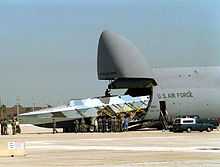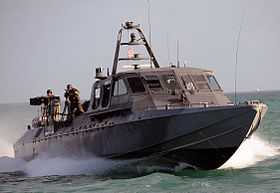Mark V Special Operations Craft
| MK V Special Operations Craft | |
|---|---|
|
A Mark V Special Operations Craft at Key West, Florida in 2009 | |
| Place of origin |
|
| Service history | |
| In service | 4 September 1995 |
| Used by | U.S. Naval Special Warfare Command |
| Specifications | |
| Weight | 57+ tons |
| Length | 25.0 m (82 ft) |
| Width | 5.25 m (17.5 ft) |
| Height |
5.25 m (17.5 ft) Draft: 1,5 m (5 ft)[1] |
|
| |
Main armament | 7.62 mm gatling guns |
Secondary armament | .50 caliber machine guns |
| Engine | 2× 2285 HP MTU 12V396 TE94 engines |
| Payload capacity | >2,950 kg (>6,500 lbs) |
| Fuel capacity | 9,840 L (2,600 gallons) |
Operational range | 500+ nautical miles |
| Speed | 65+ knots |
The Mark V SOC (Special Operations Craft) is a small marine security/patrol/transport boat manufactured by VT Halter Marine Inc (Gulfport, Mississippi). The Mark V is one of the newest additions to the United States Naval Special Warfare Command.[2]
Development
Origins
The development of the Mark V SOC was very fast-paced, taking only 18 months from the initiation of the program to actual delivery of the first boat on 4 September 1995. The USSOCOM Contracting Directorate and a dedicated Program Management team executed this effort in record time, specifically because USSOCOM was given Agency level contracting authority. The contract was fulfilled when full operational capability was met in 1999. In all, 20 Mk V SOC units were delivered to USSOCOM at a unit cost of $3.7 million. The Mark V SOC deployment, on the other hand, was less smooth. Problems included instances of the windshield and entire pilothouse assembly collapsing upon wave impact. However, these issues have been resolved and the Mark V SOC has markedly improved maritime special operations capabilities.
The original Mk V SOC was designed to address the lack of any specifically conceived SEAL insertion craft. Prior to the Mk V SOC, SEALs traveled on any form of surface transport available, often resorting to taping lawn furniture to the deck of the available craft. The original Mk V competition included three different designs, one Kevlar composite monohull, one aluminum monohull and one aluminum catamaran hull; the aluminum monohull won. The Mk V SOC specifically incorporated a modular shock mitigation seating design to minimize injury. Experience gained during training and operational usage showed the aluminum monohull transmitted the impact with the water to the craft's occupants more readily than a composite hull. Even after modifications such as the addition of shock-absorbing seats, the boats are capable of generating up to 20 Gs of force while slamming across waves. This led to many cases of bruises, sprained ankles, chipped teeth, and back, neck and joint injuries. These injuries necessitated a replacement.
Redesign
On 11 January 2008 the U.S. Navy unveiled a new version of the Mk V, dubbed the Mk V.1,[3] intended to reduced the number of injuries sustained by sailors and SEALs during the operation of the vessel. Nicknamed the MAKO, the boat will undergo testing off the coast of Maine to evaluate its new composite carbon-fiber hull before final evaluation in Norfolk, Virginia.
The MAKO was designed by Maine Marine Manufacturing LLC, a subsidiary of Hodgdon Yachts, a luxury boat builder, and the University of Maine's Advanced Engineered Wood Composites Center. The new boat will feature a hull made of layers of carbon fiber, a foam core and an outer layer of Kevlar for additional strength. The MAKO is lighter than current Mk V's.
Missions
The primary mission of the Mark V is medium range insertion and extraction platform for Special Operations Forces (primarily SEAL combat swimmers) in a low to medium threat environment. The secondary mission is limited Coastal Patrol and Interdiction, specifically limited duration patrol and low to medium threat coastal interdiction. The typical Mark V SOC mission duration is 12 hours.
For example in 2003, in one of the first actions of Operation Iraqi Freedom, Mark V SOCs operating out of Kuwait disembarked at least two platoons of Navy SEALs to capture Iraqi offshore oil terminals.[4]
Capabilities

The Mark V has the capacity to carry sixteen fully equipped SEALs to missions 500 miles (800 km) away from where they are based. They ride on seats that are designed for maximum comfort and shock mitigation in high seas or heavy maneuvering, and allows occupants to either stand or sit. With a beam of 17½ feet, the craft has enough room to carry four Combat Rubber Raiding Crafts with six outboard motors (2 spares) and fuel, to deploy forces from a clandestine distance. The ramp on the stern allows SEAL teams to ride their CRRCs right up the stern of the boat, for fast extraction and insertion.
To support the SOF missions in a medium to low threat environment, the Mk Vs are outfitted with five gun mounts for small caliber weapons supporting any combination of: M-2 .50 cal heavy machine guns, M240 or the M60 7.62 mm machine guns or Mk19 40 mm automatic grenade launchers. Together these provide 360 degrees of firing coverage. To defend against aircraft, the craft has a station for firing the Stinger Man-portable Air Defense System (MANPADS). Later improvements include mounting stations for GAU-17 Miniguns, MK 95 Twin .50 cal machine gun, MK 38 chain gun and Mk48 25 mm guns. Personal small arms of the crew and passengers can also be used to defend the craft.
The Mark V has many special features, besides its weapons, that make it more survivable while delivering sailors to their missions. Its angular design and low silhouette reduces its radar signature making it harder to spot and detect. Its V-hull design gives it good handling qualities in rough water as well as speed and shallow draft (four feet when cruising on-step). Its twin MTU 12-cylinder TE94 Diesel engines give it power and reliability and, coupled with the two K50S water jets, provides fast acceleration for operations near shore or in shallow waters as well as cutting down on the rooster tail effect that can make fast boats easier to see and track.

Mark V SOC Detachment
The Mark V SOC will normally operate in a two craft detachment with a Mobile Support Team. The operational detachment, also referred to as the basic Mark V SOC operating system, consists of:
- two Mark V special operations craft, each with a crew of five special warfare combatant-craft crewmen (also known as SWCCs);
- two Mark V SOC transporters, each with an M916A1E1 prime mover
- four M1097 HMMWVs with S250 shelters,
- two M1083 5-ton trucks for the 90 day containerized deployment support package (spare part, repair parts, consumables, etc.)
- one five-ton forklift;
- an eight-man maintenance support team, that provides technical assistance and maintenance support during mission turnaround.
A Mark V SOC detachment is deployable on two USAF C-5 Galaxy aircraft to a theater of operations within 48 hours of notification and is prepared to commence operations within 24 hours after arriving at a forward staging location. The detachment can also be delivered in-theater by well or flight deck equipped surface ships with appropriate crane and deck space capabilities, and, if appropriate, under their own power. A detachment is also transportable by road.
The Mark V SOC is operated by Naval Special Warfare Group THREE (formerly known as Special Boat Squadron ONE) and Naval Special Warfare Group FOUR (formerly known as Special Boat Squadron TWO) on the east and west coasts. Twelve Mark Vs are assigned to NSWG-3, Coronado, California, and eight to NSWG-4, Little Creek, Virginia.
Mark V Waterfront Operations Support Facility
Located at Naval Air Station North Island, San Diego, California is a new facility to house operational maintenance, training and administrative functions for 12 Mark V SOC.[5] The North Island location was designed to allow rapid mobilization and transport of these vessel worldwide. The facility provides non-depot level maintenance of rolling stock and depot level maintenance of the Mark V SOC. In addition to maintenance and supply/spare parts warehousing facilities, on-site administration and training facilities with classrooms and briefing areas were provided. Final design includes a new 115' by 37' U-shaped, reinforced concrete pier, 60' long concrete floating docks to berth five vessels, and a gangway. The pier was designed to support the combined load of a 50-ton Mark V and a 70-ton marine travel lift used to lift the vessels out of the water and transport them to the maintenance facility.
Foreign use
On 9 July 2013, Congress was notified of a request from the Royal Saudi Naval Forces to purchase 30 Mark V patrol boats, along with associated equipment, parts, training, and logistical support for $1.2 billion. The boats' mission is to protect maritime infrastructure in Saudi littoral waters. They will be used primarily to patrol and interdict intruders in Saudi territorial seas, and recognized economic exclusion zones.[6]
Replacement
In August 2014, SAFE Boats International delivered the first 10 Mark VI patrol boats to the U.S. Navy, their first new patrol boats since the 1980s. The Mark VI is more survivable and better equipped with modernized weapons, communications, and intelligence, surveillance and reconnaissance systems. A Mark VI is 85 ft (26 m) long, can travel in excess of 35 kn (40 mph; 65 km/h), and is manned by a 10-person crew with space or 8 more passengers; the boats are equipped with a covered fly bridge, reconfigurable main deck cabin, and have shock mitigating seating for greater comfort in high sea states. There is space for additional crew, payloads, and greater mission capabilities once the Navy refines the larger boat's concept of operations. The Mark VI is planned to begin its operational deployment in spring 2015, with up to 48 boats potentially to be purchased by the U.S. Navy. Safe Boats plans to market the vessel internationally, and potential customers from the Middle East and Central and South America have already made inquiries.[7]
Related articles
- Cyclone class coastal patrol ship
- Special Operations Craft - Riverine (SOC-R)
References
- ↑ "Mark V Special Operations Craft". FAS.org. Federation of American Scientists. Retrieved 25 May 2010.
- ↑ www.navy.mil "Mark V Special Operations Craft". Retrieved 30 October 2008.
- ↑ "Just Launched: Mako". John K. Hanson, Jr. 12 January 2008. Retrieved 30 October 2008.
- ↑ Dao, James (22 March 2003). "A NATION AT WAR: THE COMMANDOS; Navy Seals Easily Seize 2 Oil Sites". NYTimes.com. The New York Times. Retrieved 9 April 2012.
To protect the Seals, four Mark-5 jet-powered patrol boats, each armed with four twin-barreled 50-caliber machine guns, were stationed around the oil terminals like sentries. Navy snipers were also placed inside helicopters overhead.
- ↑ "Military Facilities". Cash & Associates. Retrieved 30 October 2008.
- ↑ Kingdom of Saudi Arabia may receive 30 Mark V patrol boats from USA - Navyrecognition.com, 11 July 2013
- ↑ Navy Receives First New Patrol Boat - Nationaldefensemagazine.org, November 2014
External links
| Wikimedia Commons has media related to Mark V Special Operations Craft. |
